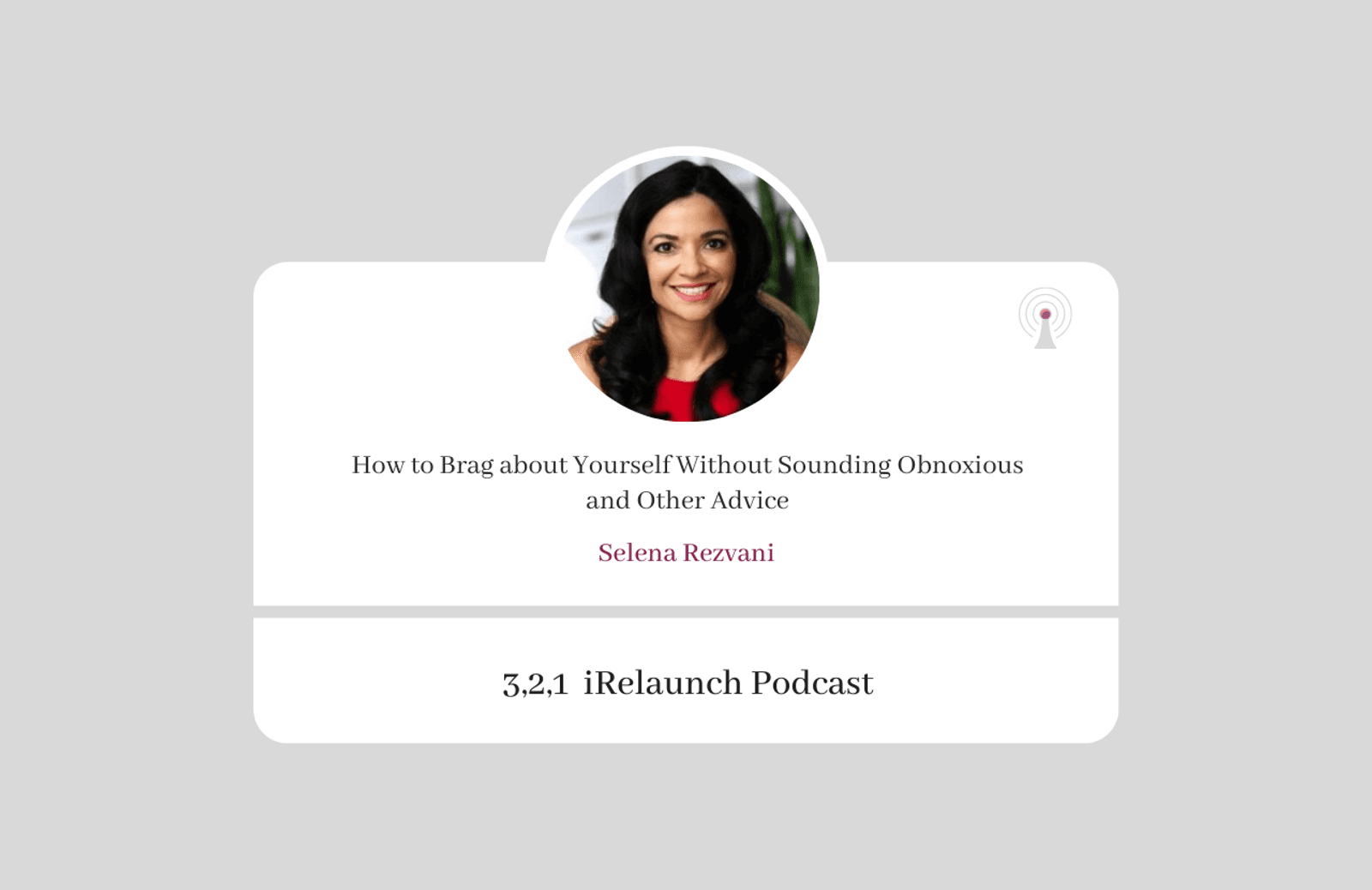

You’re different and that’s a good thing.

At this point, I had taken the time for self-reflection and clarity, and I had completed my research on iRelaunch’s business and company needs and I had connected these dots in my own mind. Now I had the task of communicating this revelation to iRelaunch’s leadership all while illustrating the unique value proposition I could bring to the company.
In a recent podcast episode with Selena Resvani , Carol and Selena discuss Jodi Glickman’s strategy of telling the narrative of your career story.
“Instead of verbally listing your long, impressive set of life experiences in your resume chronologically which is what some of us want to do when we’re put on the spot. [Jodi’s] process is to share: destination, backstory and finally to connect the dots. Destination which is, where you want to go, then your backstory of where you’ve been, and then last, what are the bridge statements that you can come up with that help those two things make sense together or help integrate and weave your story together…the beauty of this [approach] is that you’re actively shaping how you’re known. You’re training them how to see you.”
From my research on my prospective team members, I determined that I had a unique perspective and “backstory” of having worked with human resources professionals in my role at the time. Further contributing to this backstory of mine, I realized the goals of my then-clients and the goals of iRelaunch’s clients were both to attract and retain talented individuals, albeit the strategies and methods for achieving these objectives were different. As iRelaunch advises, it may be necessary to seek out professional designations or certification courses during your relaunch , whether to serve as a refresh or to lay the groundwork for a career pivot. This can also serve a strategic need as it serves as an indicator to prospective companies about the seriousness of your commitment or intent to pursue a particular position or industry. Taking this advice to heart, I began studying for my Senior Professional in Human Resources designation to indicate that commitment and to showcase an area of my expertise that could mesh with the team’s strengths and bring value to iRelaunch’s operations.
Beyond signaling the strength of my commitment to iRelaunch as my “ beautiful destination ”, I also had to make the business case extremely clear. I leaned into one of my natural strengths, what others have reassuringly described as my “analytical rigor” and developed a business proposal incorporating elements of my research and on the strategic value I could bring. This proposal gave me an opportunity to self-advocate for myself and my strengths and served as a vehicle to highlight many of those attributes: from illustrating my ability to perform effective market research, to capably designing an aesthetically pleasing presentation, to organizing a business case in a logical fashion, to exhibiting my critical thinking and problem solving skills.
For some help identifying your unique value proposition and the distinctive strengths you possess, I recommend Whitney Johnson’s book, Disrupt Yourself (particularly Chapter 2: Play to Your Distinctive Strengths, affiliate link) and Dawn Graham’s book, Switchers (affiliate link). In Switchers, Dawn differentiates between the “USP” or Unique Selling Position and the BVP or “Brand Value Proposition.”
“Humans are complex, and our personalities form through a lifetime of diverse experiences. You have a Unique Selling Point, or USP, that sets you apart from others who do similar work...Your USP is a critical part of your brand in a job search. No matter what your profession or background, something will set you apart from the competition in your field.”
“A USP is your differentiator. It shows an employer how they will get even more value if they hire you. (A qualified applicant plus someone who can communicate in Portuguese with the Brazil office? Score!) Be very specific...while you can’t fully control how others experience you, you can influence it by what you communicate.”
“Your Brand Value Proposition (BVP) describes how you solve your audience’s pain points. Essentially, a BVP pulls together all the pieces we’ve discussed to create a guidepost for how you introduce yourself, what you choose to post online, the circles you need to network into, the projects you take on, how you show up, and much more. It will be the reason a hiring manager selects you.”

While my business proposal served many purposes, the missing component I had to solve for next was how to approach iRelaunch and introduce this proposal so its leaders were compelled to meet with me. This required me to develop a verbal pitch - to refine it and finesse it and practice it on many different occasions with many different people until I felt comfortable speaking in a way that felt natural and extemporaneous (for some more great advice on this point, skip to 1:13 of Carol’s interview with Mika Brzezinski) .
"Practice talking about yourself out loud over and over again. Talk to a wall. Talk to a mirror. Record yourself on your phone. But make sure you're saying it out loud. It makes a difference." - Carol Fishman Cohen
Practicing out loud not only helps you build your confidence and conviction in the message you are saying, but I also found particular value in recording the audio only through the voice memo app on my phone. This allowed me to focus on the words and the content of my message as I could listen (hands-free) to this recording once or twice a day during a short commute to further internalize and distill my talking points.
I found Carla Bass’ communication advice and using the inverted triangle strategy most helpful here:
“Recognize that...everyone is constrained by two things: the author is constrained by time, the reader is busy (tick, tick, tick), seconds are fleeting, and you’re also constrained by space. Time and space, the author who learns how to write, how to make every single word count by leveraging that time and space often wins. And that’s where you get the confluence of that inverted triangle: the top part I teach how you strategize the message with some techniques we discussed today and the bottom part I have ten word sculpting tools which is part 2 of Write to Influence (affiliate link) that teaches you how to take your initial draft and hone it getting rid of the useless words, the redundancy, the words that hog space, making sure that you’ve got the most important information up front followed by the ancillary back up information. If you follow those techniques, that’s how you learn how to write powerfully. And that opens doors that are just unimaginable that wouldn’t open otherwise.”
To further focus on your body language and executive presence especially in preparation for a video interview, make sure you also record a video of yourself delivering your message and evaluate your performance from this lens too (no pun intended!)

When crafting the content of my verbal pitch, I once again found useful information and advice on iRelaunch’s podcast and blog posts , making sure that I leveraged powerful language to frame the conversation …“I am confident that…” instead of the tendency to downplay our conviction in our beliefs with “I think” or “I should.”
When it came time to approach Carol and request a meeting, I needed to rely on the relationship I had established with Carol over the prior months by networking and staying in touch with articles and industry studies that I thought might be interesting to her and the iRelaunch team. I also wanted to do so without showing my hand, and acknowledging the time constraint we are all up against so I continued to lean on our connection and framed the meeting objective as “wanting to provide her with an update and to gather her feedback on a concept I had developed.”
I had strategized how I could shift the conversation from pleasantries to the distilled talking points I wanted to communicate, and like a chess game, I tried to anticipate and prepare to address many of the questions I thought may arise in our discussion. As I expected the conversation to segue into a discussion of my background, I also made sure my revised resume and LinkedIn profile were polished and ready to send off immediately afterward, as well as a cover letter and executive summary of my business proposal.
It would seem as if I had all of my bases covered, right? However, before I hit “send” on my email to request a meeting with Carol, there’s one more step that I took that I would recommend anyone venturing into an interview-esque scenario prepare for ahead of time. Stay tuned for my next blog post to find out what this step is...
Join our growing relauncher communities on Facebook and LinkedIn. For more great guidance on your relaunch and updates on when return to work programs are accepting applications, events for relaunchers and more, be sure to sign up for our Return to Work Report and follow us on social media to stay informed!